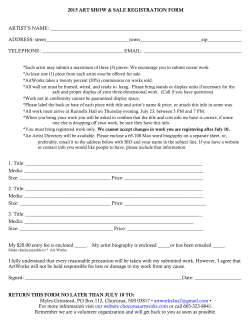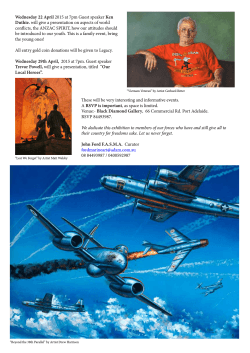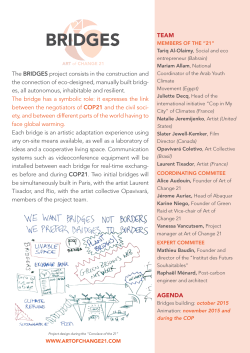
N. Dash - Casey Kaplan
N. Dash HAMMER MUSEUM N. Dash’s first solo museum exhibition was staged in the Hammer’s distinctive Vault Gallery; with its diminutive, bullet-shaped floor plan and arched ceiling, the chamber is one of the museum’s more unusual spaces, and the room’s obdurate layout underscored the role of architecture within Dash’s incisive painting practice. Here the artist mounted five untitled paintings, all 2014. A series of unframed photographs depicting frayed, curling fabric were interspersed between the seductive planar compositions, and similar images were embedded, marquee-like, within the backlit panels dotting the colonnade of the Hammer’s interior courtyard. A visible seam wraps around the walls of the Vault Gallery where they meet the room’s arched ceiling. In one work, Dash anchored along this line the horizontal joint where two indigopainted panels abut; the installation strategy emphasized the division between the room’s upper and lower segments. A third, smaller rectangular piece was mounted atop the two joined panels, and a sinewy twine cord dangling from the upper edge of the front polygon down the center of the work led the eye toward the room’s baseboard. All of the artist’s paintings- an inadequate term here, as sculptural elements aboundpossess, to varying extents,dry, cracked facades made from adobe sourced from the New Mexican desert. One fine composition consists of a swarthy, arid rectangular View of “N. Dash,” 2014-15. From left: Untitled, 2014; Untitled, 2014. plane partially hinged over another plane of a similarly grand scale (enormous roof shingles come to mind). A fold of cerulean linen peeks from between the overlaid adobeon-jute quadrilaterals. The wall work’s upper and lower sections evince vertical and horizontal striations, respectively, and recall the work of another painter indebted to the New Mexican landscape Agnes Martin. But Dash’s lines aren’t produced via accretions of paint; rather, the striations are inlaid twine strands positioned flush with the adobe surface. Formal purity and spatial logic intermingled serenely between the five panel compositions mounted here. Dash’s materials are consistently preindustrial: adobe, linen, and jute, among others. Edges and lines often maintain visual continuity across discrete works, as spreads of linen fold and wrap between and through the painted quadrilaterals. While the artist’s artisanal impulses align her labor with Arte Povera’s cultivation of raw materials (albeit omitting the overtly political tone taken by the postwar Italian movement), her wallmounted objects’ exacting geometric delineations echo Minimalism’s efforts to cut through threedimensional space (as demonstrated in work by Fred Sandback and Richard Serra, among others). Installed among her paintings, the muted images of frayed fabric bits affirmed Dash’s fixation on materials and structure. The artist photographed each worn relic after working it with her fingers to the edge of deterioration. A text accompanyipg the exhibition asserted that, in spite of their indexicalstatus as documentary photographs, the prints additionally approach the status of.”primary source material” (in the artist’s words), as unmediated and tactile as the textile artifacts theyrepresent, by virtue of the damage accrued to each photograph as it is stapled and removed, then reaffixed-its hole-punched corners visible to the wall. This ontological claim to primary status is a tenuous one if we consider that the haptic manipulation evident in the shredded fabrics is grossly disproportionate in both formal and temporal scale to the momentary damage done by the minute perforations that mark the corners of these gelatin silver prints. And though the assertion is seductive, both documentary and primary claims are hampered by characteristics that cement the prints’ status as highly calculated images whose subjects are manipulated and posed in the artist’s studio, then processed into aesthetically precious serial works. If the artist’s paintings point elsewhere-whether to adobe architecture, the New Mexican desert, or some similar sense of the works’ material origins-these untitled photographs position themselves as supporting evidence of Dash’s studio artisanry. They also lent a sleek representational counterpoint to the otherwise abstract elements that graced the gallery’s expansive walls and reached toward its vaulted canopy. - Nicolas Linnert Linnert, Nicolas. “N. Dash” ArtForum, April 2015, p. 257-258
© Copyright 2025





















